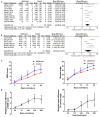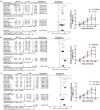The effect of metformin on ameliorating neurological function deficits and tissue damage in rats following spinal cord injury: A systematic review and network meta-analysis
- PMID: 36117612
- PMCID: PMC9479497
- DOI: 10.3389/fnins.2022.946879
The effect of metformin on ameliorating neurological function deficits and tissue damage in rats following spinal cord injury: A systematic review and network meta-analysis
Abstract
Spinal cord injury (SCI) is a devastating condition with few treatment options. Metformin, a classical antidiabetic and antioxidant, has extended its application to experimental SCI treatment. Here, we performed a systematic review to evaluate the neurobiological roles of metformin for treating SCI in rats, and to assess the potential for clinical translation. PubMed, Embase, China National Knowledge Infrastructure, WanFang data, SinoMed, and Vip Journal Integration Platform databases were searched from their inception dates to October 2021. Two reviewers independently selected controlled studies evaluating the neurobiological roles of metformin in rats following SCI, extracted data, and assessed the quality of methodology and evidence. Pairwise meta-analyses, subgroup analyses and network analysis were performed to assess the roles of metformin in neurological function and tissue damage in SCI rats. Twelve articles were included in this systematic review. Most of them were of moderate-to-high methodological quality, while the quality of evidence from those studies was not high. Generally, Basso, Beattie, and Bresnahan scores were increased in rats treated with metformin compared with controls, and the weighted mean differences (WMDs) between metformin and control groups exhibited a gradual upward trend from the 3rd (nine studies, n = 164, WMD = 0.42, 95% CI = -0.01 to 0.85, P = 0.06) to the 28th day after treatment (nine studies, n = 136, WMD = 3.48, 95% CI = 2.04 to 4.92, P < 0.00001). Metformin intervention was associated with improved inclined plane scores, tissue preservation ratio and number of anterior horn motor neurons. Subgroup analyses indicated an association between neuroprotection and metformin dose. Network meta-analysis showed that 50 mg/kg metformin exhibited greater protection than 10 and 100 mg/kg metformin. The action mechanisms behind metformin were associated with activating adenosine monophosphate-activated protein kinase signaling, regulating mitochondrial function and relieving endoplasmic reticulum stress. Collectively, this review indicates that metformin has a protective effect on SCI with satisfactory safety and we demonstrate a rational mechanism of action; therefore, metformin is a promising candidate for future clinical trials. However, given the limitations of animal experimental methodological and evidence quality, the findings of this pre-clinical review should be interpreted with caution.
Keywords: action mechanism; clinical translation; metformin; neurological function; safety; spinal cord injury; systematic review.
Copyright © 2022 Zhou, Chen, Yu, Pan, Fang, Li, Cui, Yao and Lu.
Conflict of interest statement
The authors declare that the research was conducted in the absence of any commercial or financial relationships that could be construed as a potential conflict of interest.
Figures








Similar articles
-
Neuroprotective effect and possible mechanism of edaravone in rat models of spinal cord injury: a systematic review and network meta-analysis.Front Pharmacol. 2025 Apr 7;16:1538879. doi: 10.3389/fphar.2025.1538879. eCollection 2025. Front Pharmacol. 2025. PMID: 40260386 Free PMC article.
-
Astaxanthin promotes locomotor function recovery and attenuates tissue damage in rats following spinal cord injury: a systematic review and trial sequential analysis.Front Neurosci. 2023 Oct 10;17:1255755. doi: 10.3389/fnins.2023.1255755. eCollection 2023. Front Neurosci. 2023. PMID: 37881327 Free PMC article.
-
Neuroprotective effect and possible mechanism of edaravone in rat models of spinal cord injury: a protocol for a systematic review and meta-analysis.Syst Rev. 2023 Sep 26;12(1):177. doi: 10.1186/s13643-023-02306-1. Syst Rev. 2023. PMID: 37752580 Free PMC article.
-
Effect of docosahexaenoic acid on the recovery of motor function in rats with spinal cord injury: a meta-analysis.Neural Regen Res. 2020 Mar;15(3):537-547. doi: 10.4103/1673-5374.266065. Neural Regen Res. 2020. PMID: 31571666 Free PMC article.
-
Neurological recovery and antioxidant effects of resveratrol in rats with spinal cord injury: a meta-analysis.Neural Regen Res. 2020 Mar;15(3):482-490. doi: 10.4103/1673-5374.266064. Neural Regen Res. 2020. PMID: 31571660 Free PMC article.
Cited by
-
Advancements in Antioxidant-Based Therapeutics for Spinal Cord Injury: A Critical Review of Strategies and Combination Approaches.Antioxidants (Basel). 2024 Dec 26;14(1):17. doi: 10.3390/antiox14010017. Antioxidants (Basel). 2024. PMID: 39857350 Free PMC article. Review.
-
Neuroprotective effect and possible mechanism of edaravone in rat models of spinal cord injury: a systematic review and network meta-analysis.Front Pharmacol. 2025 Apr 7;16:1538879. doi: 10.3389/fphar.2025.1538879. eCollection 2025. Front Pharmacol. 2025. PMID: 40260386 Free PMC article.
-
Metformin's therapeutic potential in spinal cord injury: a systematic review and meta-analysis on locomotor recovery, neuropathic pain alleviation, and modulation of secondary injury mechanisms.Acta Neurochir (Wien). 2025 Mar 24;167(1):87. doi: 10.1007/s00701-025-06487-7. Acta Neurochir (Wien). 2025. PMID: 40126598 Free PMC article.
-
Astaxanthin promotes locomotor function recovery and attenuates tissue damage in rats following spinal cord injury: a systematic review and trial sequential analysis.Front Neurosci. 2023 Oct 10;17:1255755. doi: 10.3389/fnins.2023.1255755. eCollection 2023. Front Neurosci. 2023. PMID: 37881327 Free PMC article.
-
Neuroprotective effect and possible mechanism of edaravone in rat models of spinal cord injury: a protocol for a systematic review and meta-analysis.Syst Rev. 2023 Sep 26;12(1):177. doi: 10.1186/s13643-023-02306-1. Syst Rev. 2023. PMID: 37752580 Free PMC article.
References
-
- Afshari K., Dehdashtian A., Haddadi N. S., Haj-Mirzaian A., Iranmehr A., Ebrahimi M. A., et al. . (2018). Anti-inflammatory effects of Metformin improve the neuropathic pain and locomotor activity in spinal cord injured rats: introduction of an alternative therapy. Spinal Cord 56, 1032–1041. 10.1038/s41393-018-0168-x - DOI - PubMed
-
- Araújo A. A. D., Pereira A. D. S. B., Medeiros C. A. C. X., Brito G. A. D. C., Leitão R. F. D. C., Araújo L. D. S., et al. . (2017). Effects of metformin on inflammation, oxidative stress, and bone loss in a rat model of periodontitis. PLoS ONE 12:e183506. 10.1371/journal.pone.0183506 - DOI - PMC - PubMed
Publication types
LinkOut - more resources
Full Text Sources

